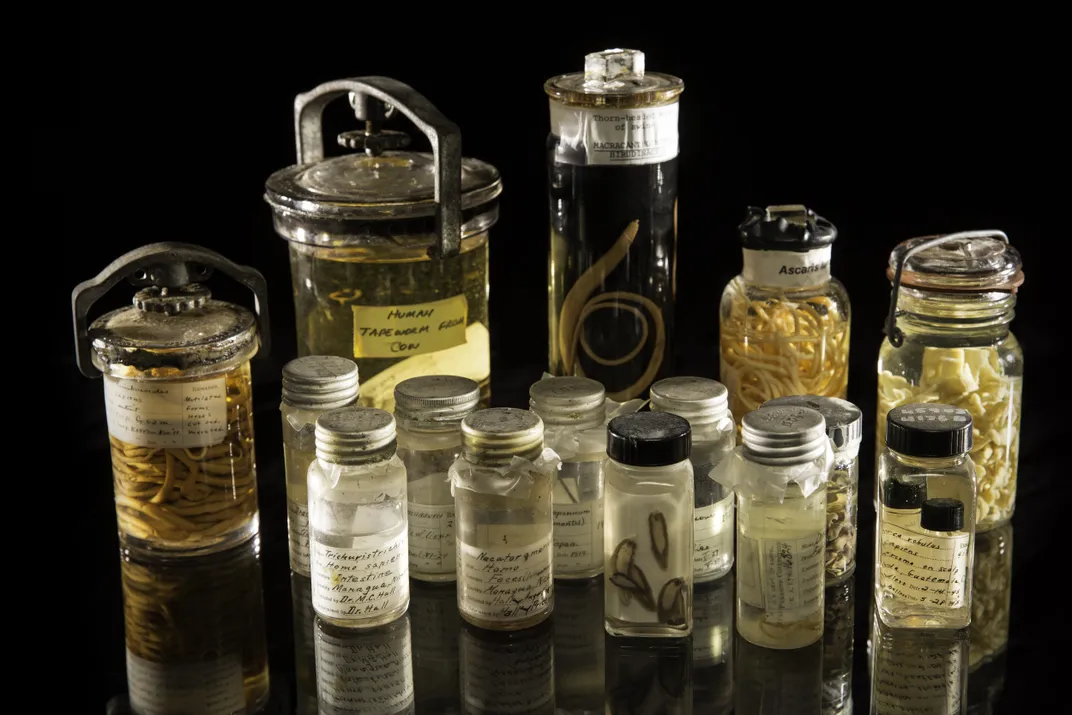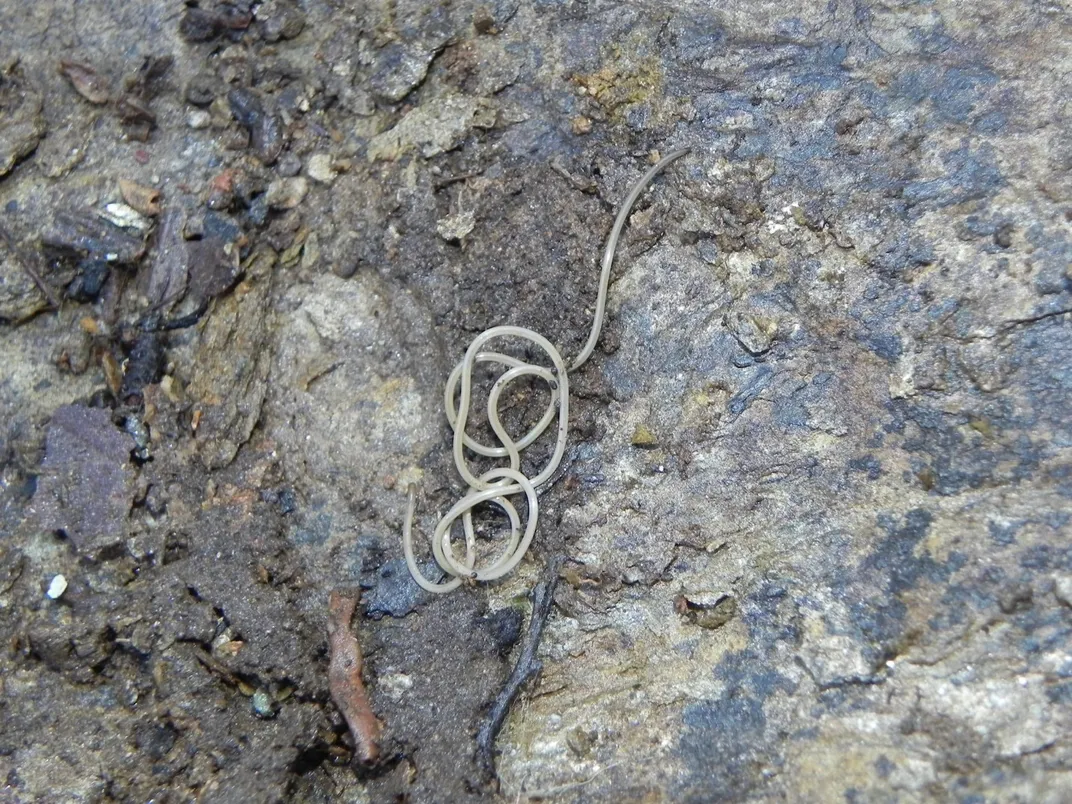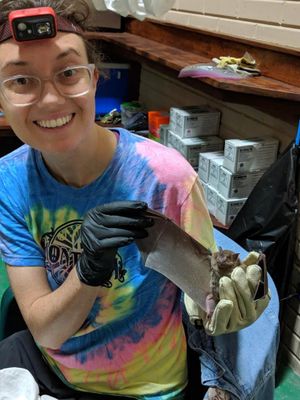NATIONAL MUSEUM OF NATURAL HISTORY
Why We Need to Save the Parasites
Parasite extinction will have lasting and far-reaching consequences for biodiversity, and subsequently for humans.
/https://tf-cmsv2-smithsonianmag-media.s3.amazonaws.com/blogging/featured/Five_red_insects_on_a_white_circle..jpg)
Do you remember the 1997 movie “Men in Black?” It’s the one where Will Smith and Tommy Lee Jones play secret agents who have to find and save the extraterrestrial Arquillian Galaxy from the dreaded “Bug.” But all they have to go on is a cryptic message delivered in the dying breaths of an Arquillian royal: “The galaxy is on Orion’s belt.”
After spending the entire movie searching the cosmos, the agents realize that what they have been looking for was hidden in plain sight — attached in a tiny marble to the collar of a pet cat named Orion.
Parasites are like the Arquillian Galaxy. Millions of parasitic worms, lice, mites and other species live right in front of our eyes. But we don’t see them until we look harder. And we must look harder, because parasites face a severe threat that only we can save them from.
A triple threat
Rather than a single villain like the “Bug,” parasites are facing several threats, including climate change, habitat loss and extinction of the plant and animal hosts that they rely on.
Recent research conducted in collaboration with the Smithsonian’s National Museum of Natural History predicts that parasites will lose 5–10% of their biodiversity by 2070 due to habitat loss alone. And 30% of parasitic worms may go extinct following the expected loss of the host species these worms need to survive.

We know that some parasites have already gone extinct due to human activities. For example, fossilized feces reveals that when humans hunted the giant moa birds to extinction in New Zealand about 600 years ago, some of the moa parasites went extinct too.
Just like the “Bug,” these global changes threaten life on Earth, including many parasitic species we don’t even know are there yet.
Saving them helps us
If you’ve been reading this post with a sense of skepticism, you’re not alone. Most biology classes leave out the importance and diversity of parasite species, so the idea of parasite conservation is probably surprising. Because they are often overlooked or avoided, parasites haven’t been included in conservation efforts, but they should be.
While parasites take resources from their host, they also give back to host communities, and they help maintain healthy ecosystems. For example, horsehair worms manipulate their grasshopper and cricket hosts to enter streams, where the worms emerge as non-parasitic adults. In Japan, these manipulated grasshoppers and crickets account for 60% of the annual energy intake of the endangered Japanese trout (Salvelinus leucomaenis japonicus). And higher abundance of grasshoppers and crickets had rippling benefits for resource abundance in the broader stream ecosystem.

Parasites even help hosts stay healthy. In fact, endangered gray wolves that were reared in captivity without parasites and then reintroduced into Yellowstone National Park were more susceptible to viral pathogens than wild coyotes and foxes in the same region.
Biodiversity loss from climate change and other environmental destruction is bad for humans too. Because parasites have the power to alter the flow of energy in ecosystems and drive the evolution of plants and animals, parasite extinction will have lasting and far-reaching consequences for biodiversity, and subsequently for humans.
How to save the parasites
Like Tommy Lee Jones and Will Smith after the Arquillian Galaxy fell into the hands of the “Bug,” we need to act fast to make up for lost time. And now we have a plan.
A newly published special issue on parasite conservation lays out a 10-year plan towards saving parasites. Central to that plan is leveraging conservation momentum and research to understand host species and learn more about their associated parasites.
We know a lot about human parasites or parasites that harm human wellbeing through their impact on livestock and crops, but we do not want to protect those harmful species from extinction. The ones we do want to save are parasites of wildlife that don’t impact human wellbeing or the survival of threatened wildlife hosts. Millions of wildlife parasites exist and might be threatened by global change, but most of these parasite species have yet to be described by science. This lack of knowledge is the greatest challenge to parasite conservation currently.

To build the foundational knowledge needed to carry out effective conservation strategies, we need more basic research on parasite species, which means we need more people to care about parasite conservation. More public momentum leads to more funding, more parasitologists-in-training, more research and more protected parasite species. You can show your support, or at least feed your curiosity, for parasites by visiting museums with parasite-themed exhibits, or by joining citizen science projects that help catalogue parasite diversity.
An Orion’s belt moment
I had my Orion’s belt moment in college when I took a course on parasites. I couldn’t believe I had overlooked this entire swath of life on Earth. But I realized that I simply didn’t see it until someone told me about it.
I’m here to tell you to keep parasites in mind; have your own Orion’s belt moment. It is crucial that we learn to appreciate parasites for what they are — complex and diverse lifeforms that are almost extraterrestrial in their strangeness, and as wonder-inducing as a galaxy contained within a marble. Without them, there are no healthy ecosystems. Without you, there is no agency to save them.
Related stories:
Together, We Can Save the Mangroves
Why Hawk Moths are the Underdogs of the Pollinator World
Five Species to Wrap Up Invasive Species Week
This Smithsonian Scientist is on a Mission to Make Leeches Less Scary

